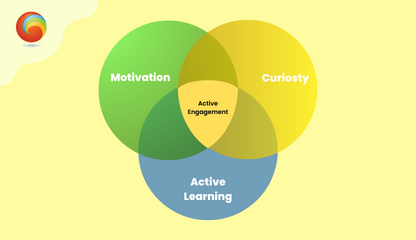Attention: The First Pillar Of Learning
Attention is the first pillar of learning.
In cognitive science, “attention” refers to all the mechanisms by which the brain selects information, amplifies it, channels it, and deepens its processing. These are ancient mechanisms in evolution: whenever a dog reorients its ears or a mouse freezes up upon hearing a cracking sound, they’re making use of attention circuits that are very close to ours.
Why did attention mechanisms evolve in so many animal species?
Because attention solves a very common problem: information saturation. Our brain is constantly bombarded with stimuli; the senses of sight, hearing, smell, and touch transmit millions of bits of information per second. At each stage, our brain decides how much importance it should attribute to such and such input and allocates resources only to the information it considers most essential.
Selecting relevant information is fundamental to learning. Very quickly, the idea of learning to pay attention spread like wildfire in the field of artificial intelligence. Today, if artificial systems manage to successfully label a picture (“A woman throwing a Frisbee in a park”), it is because they use attention to channel the information by focusing a spotlight on each relevant part of the image.
Attention, the first pillar of learning, is essential, but it may result in a problem: if attention is misdirected, learning can get stuck. This is why every student should learn to pay attention — and also why teachers should pay more attention to attention!
If students don’t attend to the right information, it is quite unlikely that they will learn anything. A teacher’s greatest talent consists of constantly channeling and capturing children’s attention in order to properly guide them.
Attention plays such a fundamental role in the selection of relevant information that it is present in many different circuits in the brain.
American psychologist Michael Posner distinguishes at least three major attention systems:
- Alerting, which indicates when to attend, and adapts our level of vigilance.
- Orienting, which signals what to attend to, and amplifies any object of interest.
- Executive attention, which decides how to process the attended information, selects the processes that are relevant to a given task, and controls their execution.
ALERTING: THE AWAKENING OF THE BRAIN
The first attention system, perhaps the oldest in evolution, tells us when to be on the watch. The oldest in evolution, tells us when to be on the watch. It sends warning signals that mobilize the entire body when circumstances require it.
It is tempting to think that a similar reorganization of cortical maps occurs every time a composer or a mathematician passionately dives into theirchosen field, especially when their passion starts at an early age.
A Mozart or a Ramanujan is perhaps so electrified by fervor that his brain maps become literally invaded with mental models of music or math. Furthermore, this may apply not only to geniuses but to anyone passionate in their work, from a manual worker to a rocket scientist, passion breeds Talent.
Even though not everyone is a Mozart, the same brain circuits of alertness and motivation are present in all people.
ORIENTING: THE BRAIN’S FILTER
Selective attention operates in all sensory domains, even the most abstract. For example, we can pay attention to the sounds around us: dogs move their ears, but for us humans, only an internal pointer in our brain moves and tunes in to whatever we decide to focus on attention radically changes brain activity.
Good teaching requires permanent attention to children’s attention. Teachers must carefully choose what they want children to attend to because only the items that lie at the focus of attention are represented in the brain with sufficient strength to be efficiently learned.
EXECUTIVE CONTROL: THE BRAIN’S SWITCHBOARD
Our third and final attention system determines how the attended information is processed. The executive control system, sometimes called the “central executive,” is a hodgepodge of circuits that allows us to choose a course of action and stick to it.
Executive control is the switchboard of the brain: it orients, directs, and governs our mental processes. The brain’s central executive is considered one of the attention systems because, like the others, it selects from many possibilities — but this time, from the available mental operations rather than from the stimuli that reach us. Thus, spatial attention and executive attention complement each other.
We cannot expect a child or an adult to learn two things at once. Teaching requires paying attention to the limits of attention and, therefore, carefully prioritizing specific tasks. Any distraction slows down or wastes our efforts: if we try to do several things at once, our central executive quickly loses track.
LEARNING TO ATTEND
Executive attention roughly corresponds to what we call “concentration” or “self-control.”
Training in executive control can even change one’s IQ. This may come as a surprise because IQ is often viewed as a given — a fundamental determinant of children’s mental potential. However, the intellectual quotient is just a behavioral ability, and as such, it is far from being unchangeable by education. Like any of our abilities, IQ rests on specific brain circuits whose synaptic weights can be changed by training.
A recent meta-analysis examined the effect of education on intelligence, and concluded that each additional year at school yields a gain of one to five IQ points.
For families at low socioeconomic levels, early intervention, starting in kindergarten and teaching the fundamentals of learning and attention, can be one of the best educational investments.
I’LL ATTEND IF YOU ATTEND
Man is by nature a social (or political) animal.
- Aristotle (350 BCE)
All mammalian species — including, of course, all primates — possess attention systems. But attention in humans exhibits a unique feature that further accelerates learning: social attention sharing. In Homo sapiens, more than in any other primate, attention and learning depend on social signals: I attend where you attend, and I learn from what you teach me.
Parents and teachers, always keep this crucial fact in mind: your attitude and your gaze mean everything for a child. Getting a child’s attention through visual and verbal contact ensures that she shares your attention and increases the chance that she will retain the information you are trying to convey.
A good teacher builds a mental model of his students, their skills and their mistakes, and takes every action to enrich his pupils’ minds.
The active verification of knowledge, the rejection of simple hearsay, and the personal construction of meaning are essential filters to protect us from deceitful legends and gurus. We must therefore find a compromise between our two learning modes: our students must be attentive and confident in their teachers’ knowledge, but also autonomous and critical thinkers, actors of their own learning.
Frequently Asked Questions
-
What are the 4 pillars of training?
- Knowledge: Acquiring the necessary information and understanding of the subject matter.
- Skills: Developing practical abilities and expertise through practice and hands-on experience.
- Attitude: Cultivating a positive mindset, motivation, and a willingness to learn and improve.
- Behavior: Incorporating learned knowledge and skills into one’s actions and daily practices.
-
What are the 4 pillars of education in India?
- The four pillars of education in India are:
- Learning to know: Acquiring knowledge, critical thinking skills, and a broad understanding of various subjects.
- Learning to do: Developing practical skills, vocational training, and the ability to apply knowledge in real-life situations.
- Learning to be: Fostering holistic development, personal growth, and nurturing values, ethics, and character.
- Learning to live together: Promoting social awareness, empathy, inclusivity, and the ability to interact harmoniously in a diverse society.
-
Who gave the four pillars of learning?
- The four pillars of learning were proposed by UNESCO (United Nations Educational, Scientific and Cultural Organization) in the Delors Report titled “Learning: The Treasure Within” in 1996.
-
What are the 4 pillars of cognition?
- There is no widely recognized or established framework that specifically identifies the “four pillars of cognition.” Different models and theories may propose different components or pillars within the field of cognition, but there is no universally agreed-upon set of pillars.



